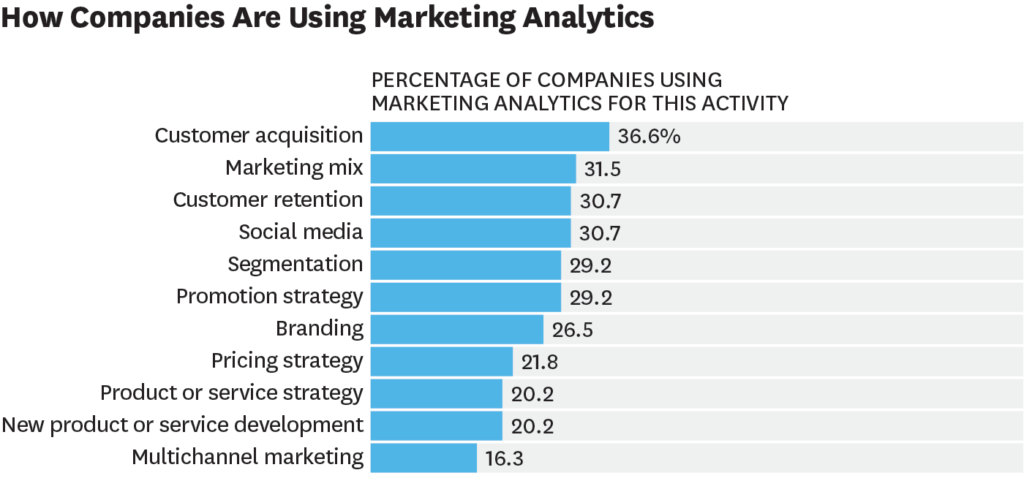Nowadays, businesses have a massive amount of data at their fingertips. From website traffic and social media engagement to customer demographics and sales figures, the volume of information available can be overwhelming. But, as the saying goes, “knowledge is power,” and this is where marketing analytics comes into play.
In this blog post, we’ll explore what is it and why it’s crucial for businesses of all sizes.
What is Marketing Analytics?
At its core, it is the process of collecting, analyzing, and interpreting data related to a company’s marketing efforts. This data can come from various sources, such as online platforms, customer databases, surveys, and more. The goal is to extract meaningful insights that inform marketing strategies and decision-making.
Also, sales & marketing analytics isn’t just about crunching numbers; it’s about gaining a deeper understanding of your customers, your campaigns, and your market. It involves tracking key performance indicators (KPIs) and using statistical techniques to uncover patterns, trends, and opportunities. In essence, it’s the science of making informed marketing choices.
Why it’s Important for Businesses to use Marketing Analytics?
Now that we’ve defined the term, let’s dive into why it’s so vital for businesses in today’s competitive landscape. There are a few useful points that aids today’s markets to gain insights. Let’s have a look…!!!
Data-Driven Decision Making
In the past, marketing decisions were often based on intuition and gut feelings. While these instincts can be valuable, they can also lead to costly mistakes. Web analytics expert provides a data-driven approach to decision-making, helping businesses make informed choices backed by concrete evidence.
For example, imagine you’re launching a new product. The insights can help you identify the most effective channels for promotion, the optimal price point, and the target audience that’s most likely to convert. By relying on data rather than guesswork, you increase your chances of success.
Understanding Customer Behavior
One of the most significant advantages is its ability to shed light on customer behavior. By analyzing data on how customers interact with your brand, you can uncover valuable insights via customer marketing analytics:
- What pages do visitors frequent on your website?
- How long do they stay on your site?
- Which products or services are the most popular?
- What prompts customers to make a purchase?
- Are there specific demographics that engage more with your content?
This knowledge allows you to tailor your marketing efforts to meet the needs and preferences of your target audience effectively.
Optimizing Marketing Campaigns
Marketing campaigns are a substantial investment of time and resources. Whether you’re running pay-per-click (PPC) ads, email marketing, or social media promotions, you want to ensure that every dollar spent generates a positive return on investment (ROI). Sales and marketing analytics provides the tools to monitor the performance of your campaigns in real-time.
With the right analytics tools, you can track metrics such as click-through rates, conversion rates, and cost per acquisition. If a campaign isn’t delivering the desired results, you can make adjustments on the fly, reallocating your budget to more successful channels or modifying your messaging to better resonate with your audience.
Enhancing Customer Engagement
In today’s highly competitive market, customer engagement is crucial for building brand loyalty and long-term success. Insights help you understand how customers engage with your brand across different touch points. This insight can lead to more personalized marketing strategies that foster stronger connections with your audience.
For instance, if you discover that a significant portion of your audience prefers engaging with your brand through social media, you can invest more in creating compelling social media content. You can also tailor your messaging to align with the specific interests and pain points of your social media audience.
Measuring and Proving ROI
For many businesses, demonstrating the return on investment (ROI) of marketing activities is a challenging task. Marketing analytics simplifies this process by providing concrete data on the impact of your efforts. You can track how much revenue each marketing channel generates and compare it to the associated costs.
Having a clear view of ROI helps you make budget allocation decisions more effectively. If you find that certain marketing channels consistently deliver a higher ROI, you can allocate more resources to those areas and scale your efforts accordingly.
Staying Competitive
In today’s business landscape, staying ahead of the competition is essential. Your competitors are likely using marketing analytics to refine their strategies and gain a competitive edge. If you’re not leveraging the power of data and analytics, you risk falling behind.
By embracing marketing analytics, you can identify opportunities that your competitors may overlook. You can also react more swiftly to changes in the market and customer preferences, ensuring that you remain relevant and competitive.
Improving Customer Retention
Acquiring new customers is essential, but retaining existing ones is equally crucial. Marketing analytics can help you identify trends in customer behavior that might signal dissatisfaction or a propensity to churn. Armed with this knowledge, you can take proactive measures to retain valuable customers.
For example, if you notice a drop in engagement from long-time customers, you can launch a targeted re-engagement campaign or offer exclusive incentives to keep them loyal to your brand.

Challenges of Marketing Analytics
Marketing analytics holds the key to unlocking valuable insights and optimizing campaigns, but it’s not all sunshine and rainbows. The journey from data to meaningful action can be riddled with challenges that can trip up even the most seasoned marketers. Let’s dive into some of the common hurdles you might encounter:
Data Overload
Information Tsunami: Modern marketing generates data from multiple sources at a dizzying pace. Websites, social media platforms, email campaigns, and CRM systems all contribute to a data deluge, making it difficult to know where to start and what to prioritize.
Quality Control: Not all data is created equal. Inaccurate or incomplete data can lead to misleading insights and faulty decision-making. Ensuring data quality through proper collection, cleaning, and validation is crucial.
Technical Barriers
Tool Fatigue: The market is flooded with marketing analytics tools, each with its own strengths and weaknesses. Choosing the right tool for your needs and budget can be a daunting task.
Skill Gap: Effectively using analytics tools requires a certain level of technical expertise. Without proper training and understanding of data analysis techniques, interpreting results and drawing actionable insights can be challenging.
Interpretation and Action
Paralysis by Analysis: Getting bogged down in endless data exploration and statistical analysis can lead to inaction. It’s important to set clear objectives, identify key metrics, and focus on extracting actionable insights that can be translated into tangible marketing strategies.
Resistance to Change: Data-driven recommendations may challenge long-held assumptions or require changes to established marketing practices. Overcoming internal resistance and effectively communicating the value of data-driven decisions is crucial for successful implementation.
Beyond the Technical
Privacy Concerns: Navigating the ever-evolving landscape of data privacy regulations can be complex. Striking a balance between collecting valuable data and respecting user privacy is essential.
Organizational Sections: Data sections within different departments can hinder comprehensive analysis and limit the potential of marketing analytics. Fostering collaboration and breaking down data sections is key to maximizing its impact.
What are the Marketing Analytics Tools & Techniques?
Marketing analytics involves using data to understand how your marketing efforts are performing and identify areas for improvement. To achieve this, you need both tools to collect and analyze the data, and techniques to interpret and apply the insights gained. Here’s a breakdown:
Marketing Analytics Tools
These are software platforms and services that help you gather, organize, and analyze data from various marketing channels. Popular options include:
Web Analytics
Google Analytics: Free and widely used, it tracks website traffic, user behavior, and conversion rates.
Mixpanel: Focuses on user engagement and funnel analysis, ideal for complex product interactions.
Social Media Analytics
Hootsuite: Tracks brand mentions, engagement, and audience demographics across social platforms.
Sprout Social: Offers similar features to Hootsuite with advanced reporting and scheduling tools.
Email Marketing Analytics
Mailchimp: Provides insights on email opens, clicks, and unsubscribes to optimize email campaigns.
Constant Contact: Analyzes email performance and offers audience segmentation tools.
Marketing Automation Tools
HubSpot: All-in-one platform for marketing automation, CRM, and analytics.
Marketo: Powerful tool for lead generation, nurturing, and campaign management, with detailed analytics.
Marketing Analytics Techniques
Once you have the data, you need to know how to use it effectively. Here are some common techniques:
Conversion Funnel Analysis: Track users as they move through your marketing funnel and identify conversion bottlenecks.
Cohort Analysis: Group users based on shared characteristics and compare their behavior over time.
Segmentation Analysis: Divide your audience into smaller groups based on demographics, interests, or behavior, then tailor your marketing to each segment.
Marketing Mix Modeling: Understand the impact of different marketing channels on sales and ROI.
A/B Testing: Test different versions of your website, emails, or ads to see which one performs better.
How to Choose the Right Marketing Analytics Tools & Techniques?
The best tools and techniques for you will depend on your specific needs, budget, and technical expertise. Here are some tips for choosing:
Identify your goals: What do you want to achieve with marketing analytics?
Consider your resources: Do you have the time and expertise to manage complex tools?
Start small and scale up: Don’t try to do everything at once. Begin with a few basic tools and techniques and add more as needed.
Seek expert help: If you’re unsure where to start, consult with a marketing analytics professional.
Remember: Marketing analytics is an ongoing process. It’s not about just collecting data, but about using it to make informed decisions that improve your marketing performance.
How to Start Marketing Analytics Process of your Business?
Getting started with marketing analytics can be exciting, but also a bit daunting! Here’s a step-by-step guide to help you navigate the process:
1. Define your goals
What do you want to achieve with analytics? (e.g., increase website traffic, generate more leads, boost conversions).
What are your business objectives? Align your analytics goals with the overall business strategy.
2. Assess your capabilities
Technical skills: Do you or someone within your team have the ability to manage and analyze data?
Existing data infrastructure: Are there any marketing tools or platforms you’re already using that collect data?
Budget: Consider the costs of tools, training, or potential external support.
3. Gather data
Choose the right tools: Select tools that align with your goals and budget (e.g., Google Analytics for website traffic, social media analytics platforms for brand monitoring).
Connect data sources: Integrate different platforms and channels to provide a holistic view of your marketing performance.
Start small: Don’t overload yourself with too much data initially. Focus on key metrics relevant to your goals.
4. Analyze and interpret data
Learn basic data analysis techniques: Understand measures like averages, percentages, and correlations.
Utilize data visualization tools: Create charts and graphs to make data easier to understand and identify trends.
Focus on actionable insights: Don’t just look at numbers, ask “why” and “what can we do about it?”
5. Take action and optimize
Translate insights into actionable strategies: Based on your findings, adjust your marketing campaigns, channels, or messaging.
Test and iterate: Continuously measure the impact of your changes and refine your approach for better results.
Communicate insights: Share your findings with stakeholders to garner buy-in and support for improved marketing decision-making.
Bottom Line
In summary, it empowers businesses to make informed decisions, understand their customers better, optimize campaigns, and ultimately drive growth. The insights gained from analysisare invaluable in a world where data is king.
Whether you’re a small startup or a multinational corporation, harnessing the power of analytics can set you on a path to success. The honest & reliable web analytics expert has accurate knowledge to work with this process. They are well-versed with the tools and can provide you accurate insights about your business.
So, if you haven’t already, it’s time to embrace data-driven marketing and unlock the full potential of your business. Your competition is already doing it, and the insights you gain can make all the difference in achieving your marketing goals and securing a bright future for your business.







